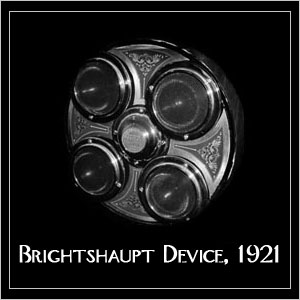The Jacquard Game
The Archivist | October 29, 2007
Twenty years before Karolson’s oppressive Canadian boredom came the extraordinary case of Gregory Aurifaber of London. Aurifaber, who has been the unfortunate victim of several generations of genealogists’ efforts to link him to the illustrious Charles Babbage through tenuous links with Georgiana Whitmore, never met the inventor of the analytical engine. He did, however, meet Babbage’s intellectual successor, Pehr Georg Scheutz, at the World’s Fair in Paris in 1855, and almost certainly made quite an impression, though Aurifaber was famously shy in public and could not speak more than a few words without a pronounced stammer. Nevertheless, whatever he said to the Swedish scientist, through this meeting, Aurifaber gained permission to work with Scheutzian engines, which followed quickly on the heels of Babbage’s quasi-successful experiments.
However, logarithmic tables did not fully occupy Aurifaber’s imagination. A dreamy child, he had surprised his parents by excelling at Cambridge in mathematics and literature, often changing his cap between calculus and Middle English so as not to be thought poorly of. Thus it is perhaps not surprising that Aurifaber, when closeted with the Scheutzian machine in London, began to surreptitiously instruct it in a simple number game in which the small balding man encouraged the bulky machine to “guess” what number he was thinking of. By narrowing the parameters with each “guess” output, he successfully engaged the analytical engine in play. But this did not, ultimately, satisfy Aurifaber.
Many believe at this point that Aurifaber succumbed to his family’s sad prediclition for gin, and this accounts for his mangling of Babbage’s original intent, and while this may or may not have been a factor in his admittedly bizarre actions, it is true that eventually Aurifaber began to feed Jacquard loom punch cards into his engine. He did not, however, use them to store primitive programs, but fed in raw cards which dictated five-pointed leaves, daffodils, English roses, Greek urns.
The effect of these cards on the functionality of the machine was extreme. It began attempting to guess what number Aurifaber was thinking of based upon these bizarre parameters.
Aurifaber offered no further numerative input, and the Scheutzian engine struggled with the problem. Finally, it extruded one of the cards, whose punches had been altered. However, the engine refused to read the card it had generated, and Aurifaber was at a loss as to how to interpret the machine’s solution.
By then, however, Scheutz had constructed a second analytical engine, which resided in the United States. Aurifaber, though mortally afraid of the water, made the long crossing in order to see the other machine. Perhaps it was gin that inspired this strange solution to an unreadable card. Perhaps not. In either case, once in the New World Aurifaber inserted the card long carried in his valise, and the new engine responded by furiously punching holes in its response tape as though it were a plain card. Aurifaber proceeded to manufacture the cards dictated by the American engine, and spent the next dozen years ferrying cards he could not read between the two machines.
One ought not to judge such a unique mind on its ability to reach obvious conclusions–that is a pedestrian pursuit that must be left to the likes of us. In his old age, Aurifaber allowed his daughter Alice to examine the cards which had become so precious to him. It was she who finally inserted the cards into a Jacquard loom and allowed it to weave out the machine’s correspondence.
The extraordinary tapestry woven by Alice currently hangs in the British Museum of Antiquities.
What emerges is essentially a complex guessing game. The English engine had begun to seek further parameters when Aurifaber ceased his input. The American machine also attempted to interpret the basic floral and abstract designs of the Jacquard loom cards by the same criteria as its opposite number: seeking an impossible “correct” number hidden among the myriad symbols and designs presented to it. The tapestry begins with uncertain flowers with stems of numbers, but quickly devolves into combinations of paisley, cartouches, egg-and-dart designs of incredible density. The two engines found a correct answer impossible to determine, and Alice herself called the tapestry: “a gorgeous horror which my heart shall never fully defeat.”
The two machines are now housed in Berlin, in adjoining rooms, and with extreme care are allowed to continue their game, the first recorded, though certainly not the last, in which two computers played one another, using a human psyche as console.
[[Archive Group: Attic. Lockwords: Operator Corruption, Sneakernet, Accidental Artifacts, Scheutz Inversion, Unbounded Nondeterminism. Last Accessed 9.001.6.7.13, UIN# (47)663.5-9]]
Comments are closed.
-->



